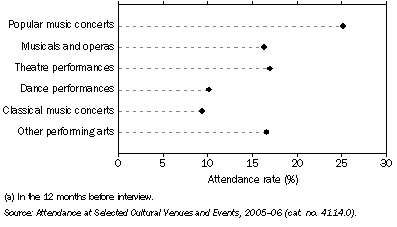I was reading with interest the recent report from the Australian Bureau of Statistics concerning arts and culture in Australia. The data provided in the report while addressing a number of different aspects of the participation and purchase of music nonetheless is a collection of data from different periods in time, lacks any real cohesive character and is for the most part incapable of providing a basis on which an overall assessment or analysis can be undertaken. What follows is a summary of some of the main areas the report addresses however it is worth noting that the data is very dated and unrepresentative of the present day situation.
Attendance at Concerts
The following graph notes that popular music concerts in 2005-2006 were the most popular form of entertainment with 25% of people interviewed stating that they had attended a concert in the previous 12 month period. Over 39% of concert goers attended more than one event in a year.
12.1 ATTENDANCE RATES FOR THE PERFORMING ARTS(a) - 2005-06

Forty percent of respondents that attended a popular music concert were within the 18-24 year age group. This reduced gradually with each age group with fewer that 7% of those aged 75 years and over attending a concert.
Wholesale of Music
Disappointingly the ABS have chosen to reproduce the wholesale music statistics provided by the Australian Recording Industry Association for the year 2008-2009. I have written about these statistics before here . Notably however, these statistics do not represent all music sold in Australia rather just those that are members of ARIA.
Household Expenditure on Music
The Australian Bureau of Statistics report that pre-recorded CDs and records are at best in the mid range for items on which Australians spend their household income. Overall Australians spent 4% of the income in the 2003-2004 period on cultural experiences.
3.1 AVERAGE WEEKLY HOUSEHOLD EXPENDITURE ON CULTURE(a) - 2003-04

Notably this data does not appear to include digital sales however on average Australians spent $1.60 per week on pre recorded CDs and records and $0.05 per week on cassettes and tapes in 2003-2004. On a yearly basis Australians spent $646m per year on CDs and records and $19m on cassettes and tapes.
Factoring in inflation over the period between 1984 and 2003-2004 there was a gradual increase in the amount of money the average household spent on music followed by a drop. In 1984 Australians spent $0.68 cents per week on music, in 1988-1989 this rose to $1.21 per week. In 1993-1994 this rose again to $1.29 per week, and again in 1998-1999 to $2.07 per week. In 2003-2004 average weekly expenditure on music dropped to $1.65 per household.
Output of Cultural Industries
The output of the Australian cultural industries is quantified through reference to the Australian National Accounts and an earlier report by the Australian Bureau of Statistics titled Australian Industry, Catalogue No. 81550.
The Australian National Accounts indicate that in 2004-2005 pre-recorded audio and video tapes, disks and records that were either manufactured of published amounted to $1.723m or made up 4.1% of all cultural goods and services.
The Australian Bureau of Statistics report Australian Industry, Catalogue No. 81550 further demonstrates the output of cultural industries. Comparing 2006-2007 to 2007-2008, the report provides detailed data with respect to motion picture and sound recording activities breaking the analysis into the following categories: Printing (including the reproduction of recorded media), Publishing (except internet and music publishing), Motion picture and sound recording activities, Broadcasting (except internet), Internet publishing and broadcasting, Library and other information services, Heritage activities and Creative and performing arts activities.
In conclusion the Arts and Culture in Australia: A Statistical Overview, 2009 report is a cobbled together collection of outdated data with a distinct lack of consistency with respect to its collection and analysis. Whilst perhaps useful as independent components this report does little to provide a holistic or useful depiction of Australians involvement in music. This report whilst indicative of the level of production, exposure and consumption of arts in Australia appears to be the only one ever prepared by the Australian Bureau of Statistics and without a history of statistical analysis of these aspects of Australian society and our interaction with the arts it is not possible to make a comparative analysis or establish trends over time. A more useful approach would be a survey addressing each of these issues in turn at the one time with ongoing repetition enabling a far clearer understanding to be gained as to the experiences of Australians with the arts.
Further Information
Australian Bureau of Statistics, 4172.0 - Arts and Culture in Australia: A Statistical Overview, 2009 (21 October 2009) <http://www.abs.gov.au/ausstats/abs@.nsf/Latestproducts/4172.0Main%20Features12009?opendocument&tabname=Summary&prodno=4172.0&issue=2009&num=&view=> at 31 October 2009
Attendance at Concerts
The following graph notes that popular music concerts in 2005-2006 were the most popular form of entertainment with 25% of people interviewed stating that they had attended a concert in the previous 12 month period. Over 39% of concert goers attended more than one event in a year.
12.1 ATTENDANCE RATES FOR THE PERFORMING ARTS(a) - 2005-06
Forty percent of respondents that attended a popular music concert were within the 18-24 year age group. This reduced gradually with each age group with fewer that 7% of those aged 75 years and over attending a concert.
Wholesale of Music
Disappointingly the ABS have chosen to reproduce the wholesale music statistics provided by the Australian Recording Industry Association for the year 2008-2009. I have written about these statistics before here . Notably however, these statistics do not represent all music sold in Australia rather just those that are members of ARIA.
Household Expenditure on Music
The Australian Bureau of Statistics report that pre-recorded CDs and records are at best in the mid range for items on which Australians spend their household income. Overall Australians spent 4% of the income in the 2003-2004 period on cultural experiences.
3.1 AVERAGE WEEKLY HOUSEHOLD EXPENDITURE ON CULTURE(a) - 2003-04
Notably this data does not appear to include digital sales however on average Australians spent $1.60 per week on pre recorded CDs and records and $0.05 per week on cassettes and tapes in 2003-2004. On a yearly basis Australians spent $646m per year on CDs and records and $19m on cassettes and tapes.
Factoring in inflation over the period between 1984 and 2003-2004 there was a gradual increase in the amount of money the average household spent on music followed by a drop. In 1984 Australians spent $0.68 cents per week on music, in 1988-1989 this rose to $1.21 per week. In 1993-1994 this rose again to $1.29 per week, and again in 1998-1999 to $2.07 per week. In 2003-2004 average weekly expenditure on music dropped to $1.65 per household.
Output of Cultural Industries
The output of the Australian cultural industries is quantified through reference to the Australian National Accounts and an earlier report by the Australian Bureau of Statistics titled Australian Industry, Catalogue No. 81550.
The Australian National Accounts indicate that in 2004-2005 pre-recorded audio and video tapes, disks and records that were either manufactured of published amounted to $1.723m or made up 4.1% of all cultural goods and services.
The Australian Bureau of Statistics report Australian Industry, Catalogue No. 81550 further demonstrates the output of cultural industries. Comparing 2006-2007 to 2007-2008, the report provides detailed data with respect to motion picture and sound recording activities breaking the analysis into the following categories: Printing (including the reproduction of recorded media), Publishing (except internet and music publishing), Motion picture and sound recording activities, Broadcasting (except internet), Internet publishing and broadcasting, Library and other information services, Heritage activities and Creative and performing arts activities.
In conclusion the Arts and Culture in Australia: A Statistical Overview, 2009 report is a cobbled together collection of outdated data with a distinct lack of consistency with respect to its collection and analysis. Whilst perhaps useful as independent components this report does little to provide a holistic or useful depiction of Australians involvement in music. This report whilst indicative of the level of production, exposure and consumption of arts in Australia appears to be the only one ever prepared by the Australian Bureau of Statistics and without a history of statistical analysis of these aspects of Australian society and our interaction with the arts it is not possible to make a comparative analysis or establish trends over time. A more useful approach would be a survey addressing each of these issues in turn at the one time with ongoing repetition enabling a far clearer understanding to be gained as to the experiences of Australians with the arts.
Further Information
Australian Bureau of Statistics, 4172.0 - Arts and Culture in Australia: A Statistical Overview, 2009 (21 October 2009) <http://www.abs.gov.au/ausstats/abs@.nsf/Latestproducts/4172.0Main%20Features12009?opendocument&tabname=Summary&prodno=4172.0&issue=2009&num=&view=> at 31 October 2009


No comments:
Post a Comment